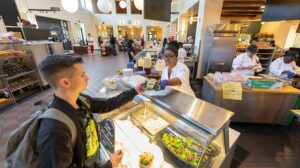
As college students prepare to return to their dorms, some of them will be worried about getting enough to eat during the school year. According to Feeding America, food insecurity is “a lack of consistent access to enough food for every person in a household to live an active, healthy life.” While many sources estimate that one in three college students struggle with food insecurity, one literature review found estimates as high as 41% of students, and even 73% of students at some Historically Black Colleges and Universities.
Ironically, many food-insecure students have on-campus meal plans. One study found that 36% of students with meal plans reported being food insecure—including 26% of students with unlimited plans. A deeper dive indicated that many of these on-campus foodservice operators are not effectively engaging students to meet their specific needs.
At FoodserviceIP, we’ve conducted in-depth analyses on College and University Foodservice Operations, and how they can better serve students. Here are a few examples of how colleges and universities are improving student engagement, and potentially relieving food insecurity in the process.
Use Labor-Saving Technology to Bring In Excluded Students
According to the studies cited above, many food-insecure students struggle to access their meal plans because dining hall hours or locations are not accessible. If you are stuck in a chemistry lab until 10 pm and the only late-night food option is far away, you may just go hungry.
Operators could stay open longer or open more locations on campus, but that would increase labor costs. Foodservice IP found that 85% of college and university operators cited labor costs as one of their major challenges. Operators need ways to expand their geographic footprint and hours without increasing labor demands. Technology could be an option.
Several colleges are leveraging labor saving devices to improve students’ access to food. For example:
- Cal State Fullerton partnered with Auxiliary Services Corporation (their on-campus foodservice operator) to create an app that sends students timely, detailed alerts when free food is available after catered events. Now a student who is stuck in the chemistry lab can easily snag leftovers from the nearby faculty meeting. It feeds hungry students, saves workers’ time, and reduces food waste.
- More than 25 colleges and universities have partnered with Starship to enlist AI-powered drones to deliver meal plan food to hungry students across their campuses. This enables current foodservice staff to “operate” everywhere. While these colleges may not have partnered with Starship specifically to address food insecurity, it is the increased accessibility these drones provide could improve student nutrition anyway.
Expand Grocery and Payment Options
To achieve food security, people need dietary diversity, especially fresh produce and culturally relevant food. College students may be able to scrounge up free pizza every day by attending on-campus events, but pizza alone will not give them the nutrition they need to thrive.
FoodserviceIP’s data shows that college students crave variety. For example, 72% of students told us they wanted more fresh and local items (i.e., fruits and vegetables) and 56% wanted more foods and beverages from various ethnic traditions (i.e., culturally relevant food).
SNAP benefits could help students access fresh produce and other grocery items, but most on-campus operators do not accept EBT/SNAP as a payment option and 69% of students who are eligible for SNAP do not receive benefits.
Several universities have met the near universal demand for fresh, culturally relevant food while supporting food-insecure students. For example:
- Florida State University and their foodservice partner Aramark run a convenience store stocked with fresh produce and groceries. Students can purchase items with cash, meal plan dollars, or SNAP benefits. This is Aramark’s first on-campus operation to accept EBT/SNAP.
- In 2009, the Commonwealth of Massachusetts determined that community colleges work with the students who are most likely to be SNAP eligible, and empowered administrators and foodservice staff to identify and support students in accessing these benefits. Other states have followed suit. This is a promising approach, but these foodservice providers could deepen their impact by developing ways for students to use their benefits on campus.
The Bottom Line
College is hard. It’s harder when you’re hungry. Food insecure students are 40% less likely to graduate.
Whether colleges run their own foodservice operation or contract it out to a third party, it should be a priority to ensure that all students are able to consistently access nutritious food. On-campus operators can improve customer service and value to all students while improving food security for struggling students at the same time. By leveraging labor saving technology, offering groceries, and accepting SNAP, foodservice operators can improve their business bottom line while potentially improving students’ long-term health, nutrition, and graduation outcomes.
Tim Powell is a Principal with Foodservice IP, a professional services firm aimed at delivering ideas for managers to guide informed business decisions.
To learn more about FSIP’s Management Consulting Practice, click here.
Like the content? Sign up to receive our communications.
Recent Comments